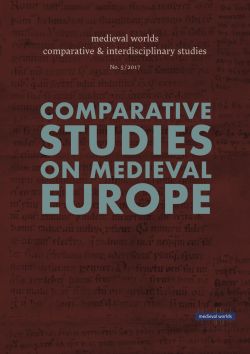Patrick Wadden
S. 143 - 169
doi:
10.1553/medievalworlds_no5_2017s143
Verlag der Österreichischen Akademie der Wissenschaften
Abstract:
There is abundant evidence for the existence of the Irish nation as a concept in the early medi eval period. A variety of texts, in both Latin and the vernacular, depict the people of Ireland as a community of birth, language, law, religion and, sometimes, politics. The creation and re-creation of ethnic and national identities elsewhere in late-antique and early medieval Europe, sometimes called ethnogenesis, has become a key concern of historians of this period in recent decades. This study of ethnogenesis prioritises interaction with the Roman Empire and political unity as precursors to the development of common identity among barbarian peoples. This model does not appear appropriate to explain developments in Ireland, where political fragmentation and divisions among the learned classes mitigated against the evolution of a common identity inclusive of all Irishmen. That such an identity emerged by the close of the sixth century, and gained popularity during the seventh, is discussed here in light of developments within the Irish Church, including the controversy around the Easter debate and attempts on behalf of Armagh to claim ecclesiastical primacy within Ireland. The process is elucidated through comparison with identity-formation in Anglo-Saxon England, as it can be observed primarily through the work of Bede. The result is to highlight the signifi cance among early medieval ecclesiastical scholars of the perceived role of national apostles in establishing national churches. Ultimately rooted in their understanding of the Bible, these ideas could be deployed in both Ireland and England in support of the claims of specific churches to ecclesiastical authority.
Ireland; national identity; ethnogenesis; Columbanus; Armagh; Muirchú; Tírechán; Liber Angeli; St. Patrick; national apostles; Bede
Published Online:
2017/06/30 14:11:58
Object Identifier:
0xc1aa5576 0x00369e51
Rights:All rights reserved.For questions regarding copyright and copies please contact us by email.
MEDIEVAL WORLDS provides a new forum for interdisciplinary and transcultural studies of the Middle Ages. Specifically it encourages and links comparative research between different regions and fields and promotes methodological innovation in transdisciplinary studies. Focusing on the Middle Ages (c. 400-1500 CE, but can be extended whenever thematically fruitful or appropriate), MEDIEVAL WORLDS takes a global approach to studying history in a comparative setting.
MEDIEVAL WORLDS is open to regular submissions on comparative topics, but also offers the possibility to propose or advertise subjects that lend themselves to comparison. With a view to connecting people working on related topics in different academic environments, we publish calls for matching articles and for contributions on particular issues.
Table of Contents
Walter POHL, Editor’s Introduction
The Sudden Success of Prose –
a Comparative View of Greek, Latin, Old French and Old Norse
Lars Boje Mortensen
Could Isidore’s Chronicle Have Delighted Cicero? A Response
Richtard W. Burgess and Michael Kulikowski
Revisiting Pre-Modern Ethnicity and Nationhood: Preface
Ilya Afanasyev and Nicholas S. M. Matheou
»Becoming English«: Nationality, Terminology,
and Changing Sides in the Late Middle Ages
Andrea Ruddick
Reinventing Roman Ethnicity in High and Late Medieval Byzantium
Yannis Stouraitis
The Characteristics of Bodies and Ethnicity c. 900-1200
Claire Weeda
Rethinking Ethnicity and ›Otherness‹ in Early Anglo-Saxon England
James M. Harland
Church, Apostle and People in Early Ireland
Patrick Wadden
Digitising Patterns of Power (DPP):
Applying Digital Tools in the Analysis of Political and Social Transformations
in the Historical Region of Macedonia (12th–14th Centuries)
Mihailo St. Popović and Veronika Polloczek
The Bible in Historical Perception and Writing
of the Transcultural Iberian Societies, Eighth to Twelfth Centuries
Matthias Tischler und Patrick Marschner
The journal is funded by the Austrian Science Fund (FWF).






 Home
Home Print
Print
 References
References
 Share
Share
